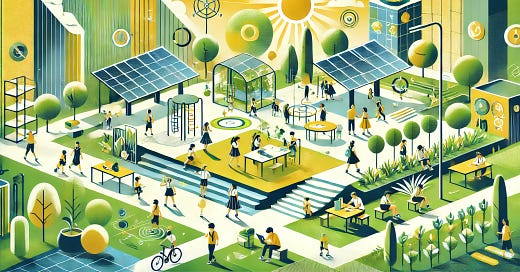027 - Education
As Technology Enables Personalized, Lifelong Learning, We Must Reimagine Both the Classroom and the Teacher
Editors Note: This blog article is an AI-supported distillation of an in-person event held in San Francisco on 2023-07-23 facilitated by . It does not reflect the views of the facilitators, writer, or the Ai Salon - it is meant to capture the conversations at the event. Quotes are paraphrased from the original conversation.
⏱️ Note! This conversation happened over a year before publishing this blog.
👉 Jump to a longer list of takeaways and open questions
Reimagining Education in the Age of AI: From Historical Accident to Intentional Design
Education's current form emerged from a complex interweaving of historical forces, creating institutions that serve multiple, sometimes competing purposes. As one educator noted in our discussion, "Currently, it's been referred to as industrial era education because industrialization happened... classrooms need to be at work in the factories, kids need to be babysat and summer needs to be off so they can go harvest."
But this industrial model wasn't the first transformation of education. The Protestant Reformation drove a push for Biblical literacy, fundamentally changing the purpose of education in Northern Europe. As one participant explained, "The Lutherans didn't teach kids to read because they wanted them to be economically productive. They taught kids to read because they wanted them to read the Bible." This spiritual dimension of education - the development of character and understanding - persists in tension with more practical aims.
The nation-state added another layer of purpose. Speaking to historical motivations for educational instructions, "back in Europe, it's very much the need of the nation state... we're producing workers and we're producing citizens, particularly citizens with a particular nation or nationality. So you're homogenizing the populace." This political dimension of education remains crucial - as another participant noted, "Education is extremely political, and it's always been a political tool,."
Today's educational institutions bundle together numerous functions:
Knowledge transfer and skill development
Character formation and socialization
Evaluation and credentialing
Childcare and social services
Cultural homogenization and civic preparation
Economic preparation and job training
While this bundling made sense in an era of scarce resources and limited technology, artificial intelligence is creating the possibility—perhaps the necessity—of unbundling these functions and redesigning them intentionally.
Main Takeaways
Traditional education combines multiple functions that could potentially be separated and optimized independently
AI enables unprecedented personalization while raising questions about the continued importance of standardization
The role of teachers and classrooms needs reimagining given AI's capabilities
Technology could enable a shift from time-bounded to continuous learning
The tension between spiritual/personal growth and practical skills requires careful consideration
Educational equity remains a crucial consideration in any technological transformation
The Complex Dance of Standardization and Personalization
The tension between standardization and personalization represents one of education's most fundamental challenges. As one participant articulated, standardization serves multiple crucial purposes: "It's not just about teaching people things. It's about assessing relative competencies that we use to award positions of responsibility in society... everyone had the same textbook, everyone had the same lecture, everyone has the same test, and who's able to best make sense of the things they were told and use them to critically think and answer questions."
This standardization serves both practical and political purposes. It enables comparison and evaluation across large populations, but it also serves to create shared cultural touchstones and common understanding. As one participant wryly noted, "It might be useful to be part of Norwegian society to know some Norwegian history."
However, AI tutoring systems are now enabling unprecedented levels of personalization. The participants imagined AI systems that can create student-specific metaphors to help drive home a particular lesson. For example, AI systems might teach algebra using soccer analogies if that makes the content more understandable or compelling to a student. This kind of contextual, personalized learning would represent a dramatic shift from the one-size-fits-all approach of traditional education.
The potential goes even deeper. As one participant explained: "You can go on and say, explain some concept to me. It starts off, and I might interrupt, saying ‘actually that was too low level. Actually, I have a PhD in psychology. Can you explain to me as you would for someone with my background?’" This dynamic adaptation to the learner's level and background represents a fundamental shift in how knowledge can be transmitted.
The Evolving Classroom and Teacher's Role
If AI can handle much of the direct knowledge transfer, what becomes the purpose of physical classrooms and human teachers? Our discussion revealed several crucial and persistent roles:
Social Learning and Development
"Human collaboration is super important, especially when you're young," noted one teacher. The classroom provides crucial opportunities for peer learning and social development that can't be replicated through individual AI tutoring. As another participant observed, "We all know probably one or two home school friends that are really challenged socially." This was the first and most obvious area where people saw the value of the classroom - a safe space for children to begin engaging with peers and adults.
Facilitation Rather Than Instruction
Another perspective was related to the “flipped classroom” idea. Transmission of knowledge is handled individually, perhaps at home, supported by an AI tutor. The classroom is an opportunity to actively use this information within groups, and the teacher is a guide to make this time as valuable as possible. "The teacher is the facilitator, but the teacher is not the person who gives all the knowledge," explained one educator. This shifts the teacher's role from knowledge provider to learning coach and discussion facilitator.
The Power of Human Connection
The human element of education emerged as crucial in multiple ways. One participant noted a potential limitation of AI tutors: "There's something there about wanting to be like them [human tutors] that I think could be a potential wrinkle in this relationship with AI." Essentially, the aspiration to emulate or impress a teacher or mentor might be difficult to replicate with AI systems. The motivation that comes from the teacher-student relationship should not be overlooked, and provides value beyond knowledge transfer. Other participants brought up the continued effort to get more diverse representation in schools, driven by a similar theory that students do better if they can identify themselves with their teachers. If this theory holds water, it’s hard to imagine a more dissimilar teacher than a disembodied AI chatbot (though perhaps AI avatars could provide a convincing enough illusion to sidestep this worry!).
Continuous Learning: A New Paradigm
Perhaps the most transformative possibility is the shift from time-bounded to continuous learning. Learning currently requires resources that are expensive, and thus generally accessed along with other people. This forces schedule coordination and great expense, which makes it more difficult to pursue later in life. While MOOCs have helped here and represent the beginning of this shift, AI may accelerate it.
This may be needed as careers are not as static as they once were! As one participant observed: "We're in a time where people are switching careers more often... We're able to actually think of other places where we can go and map a trajectory from where we are to some other area that better conforms to society's needs today."
This shift challenges the traditional model where education is concentrated in our early years. Instead, AI could enable lifelong learning that's:
Personalized to individual needs and interests
Available on-demand
Integrated with work and life
Adaptive to changing circumstances
One participant described their experience with this shift: "I was a psychologist for a decade, now I work in AI governance. Like that's a different world that has been allowed by access to the Internet, and an ability to constantly learn."
However, this vision faces significant challenges. As one participant noted: "The pace of our learning and the amount of knowledge which we can hold still remains limited. So even if, let's say, I have a tool where I can go every day and I can ask anything out of the world, my learning will be restricted to certain amount of how much I can consume and how much I can remember."
The challenge of continuous learning also relates to motivation and structure. One participant observed: "We have to raise the bar" in terms of expectations, as AI tools make information more accessible. Another noted that continuous learning requires "not just access to information versus access to intelligence or access to motivation."
Looking Forward: Challenges and Opportunities
The unbundling of education's various functions—enabled by AI—creates both opportunities and challenges. While AI can handle much of the direct knowledge transfer, human teachers and physical classrooms remain crucial for social development, motivation, and facilitation. The key will be designing systems that leverage each component's strengths rather than trying to force AI into traditional educational models. Like many industries, the approaches that will be most successful have likely not been invented yet. Education will be reimagined with AI as foundational reality, with profound consequences for our more scarce resources - our time and the labor of human educators.
Notes from the conversation
Education serves multiple concurrent purposes: knowledge transfer, socialization, economic productivity, and personal fulfillment
The distinction between formal education and learning is becoming increasingly important in the AI era
Critical thinking development may require intentionally restricted access to AI tools in certain contexts
The role of teachers is evolving from knowledge providers to facilitators and motivators
Social and emotional aspects of education remain crucial and may be difficult to replicate with AI
Standardized curriculum serves both pedagogical and political functions
Personalization through AI could enable better matching of learning styles and pace
The exploration-exploitation trade-off in learning takes on new dimensions with AI tools
AI could help democratize access to quality education while potentially creating new inequities
The relationship between students and AI tutors raises questions about motivation and accountability
Community and peer learning remain essential even as individual instruction improves
The tension between spiritual/personal growth and practical skills persists in educational design
AI tools might enable a return to more discussion-based higher education
Current educational institutions serve multiple functions beyond learning (credentialing, daycare, etc.)
The role of specialized knowledge vs. general critical thinking skills is being reconsidered
Educational equity requires considering technology access and cultural context
AI could enable more continuous, lifelong learning models
The relationship between standardization and assessment needs reconceptualization
Teacher-student relationships have important emotional and aspirational components
The balance between technology-enabled and technology-restricted learning environments requires careful consideration
Questions
How can we preserve critical thinking skills while leveraging AI assistance?
What is lost when AI systems mediate the learning process?
How do we balance standardization needs with personalization possibilities?
What role should human teachers play in an AI-enhanced educational system?
How can we maintain social development in increasingly personalized learning?
What metrics should we use to evaluate AI-assisted learning outcomes?
How do we prevent AI from amplifying existing educational inequities?
What is the right balance between exploration and exploitation in learning?
How can we foster intrinsic motivation in AI-supported learning environments?
What aspects of education require human presence versus AI assistance?
How do we maintain accountability in personalized learning systems?
What role should standardized testing play in an AI-enabled world?
How can we ensure AI systems promote rather than inhibit deeper understanding?
What is the appropriate balance between content knowledge and learning skills?
How do we preserve the spiritual/personal growth aspects of education?
What role should state interests play in AI-enhanced education?
How can we ensure AI systems develop alongside pedagogical best practices?
What is the right mix of technology-enabled and technology-restricted learning?
How do we maintain human connection in increasingly AI-mediated education?
What skills become more versus less important in an AI-enhanced world?






